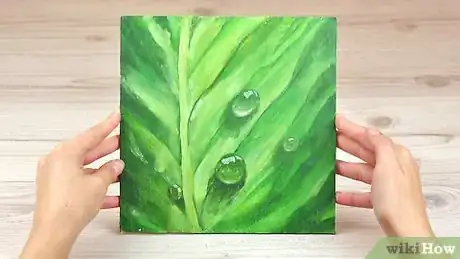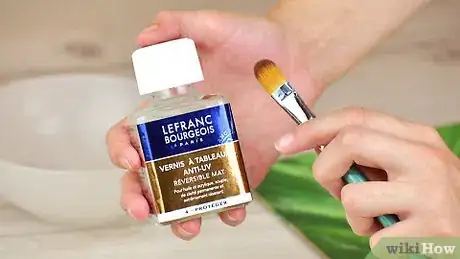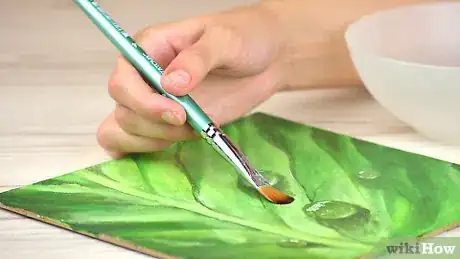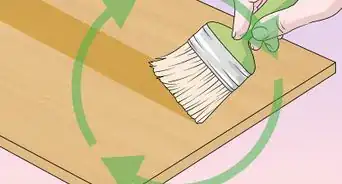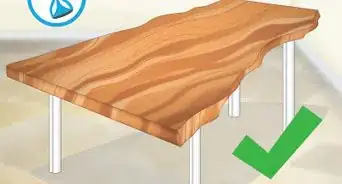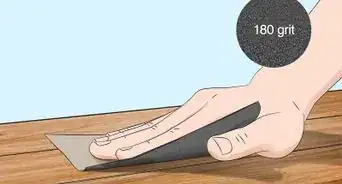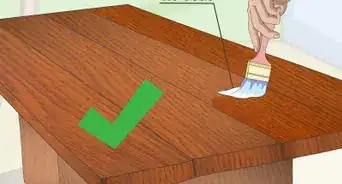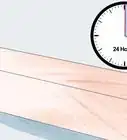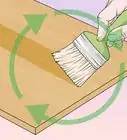This article was co-authored by Andres Matheu. Andres Matheu is the Owner of Hömm Certified Painting Systems, an Interior and Exterior Residential painting business based in the Washington, DC Metro area. Andres specializes in interior and exterior residential painting, color consultations, cabinet refinishing, wallpaper removal, and epoxy flooring among other services. An EPA Lead-safe Certified Firm, Hömm Certified Painting Systems has been awarded the Best of Houzz 2019 Service, Angie's List Super Service Award 2019, and Northern Virginia Magazine's 2018 Best Home Experts (painters) award.
wikiHow marks an article as reader-approved once it receives enough positive feedback. In this case, several readers have written to tell us that this article was helpful to them, earning it our reader-approved status.
This article has been viewed 290,829 times.
Varnish can provide a beautiful finish to wood projects and paintings. Before applying varnish to wood, sand your piece and clean your workspace.[1] Apply the varnish in several thin layers, letting each one dry thoroughly before proceeding to the next. To varnish a painting, let it dry completely and then carefully brush the varnish on. One coat is enough for many paintings, but you can add an additional layer as long as you first let the previous one dry thoroughly.
Steps
Preparing to Varnish Wood
-
1
-
2Clean your workspace.[4] Varnish is beautiful, durable finish, but it is prone to attracting dust, hair, and other impurities before it dries. Plan to varnish your piece in a place that is clean and will not be disturbed.[5]
- Try to apply the varnish in a different location than the one you sanded your piece in.
- If you have to use the same location, vacuum (don’t sweep) thoroughly after sanding.
- Wet mopping the floor before you begin can also help keep dust down.
Advertisement -
3Gather your varnishing supplies. You’ll only need a few basic supplies to varnish wood. All of them are readily available at your local hardware store. Make sure to get:[6]
- Varnish (read the label carefully to make sure it is true oil-based varnish, not polyurethane)
- A paintbrush (natural bristle is preferable)
- A stirring stick
- A large, clear measuring cup with markings on the side
- Paint thinner (turpentine or mineral spirits)
- Rubber gloves and a respirator (optional)
-
4Stir the varnish carefully. Avoid shaking the container of varnish. Open it carefully, and use your stick to stir the varnish thoroughly. Work slowly and gently -- you don’t want to introduce air bubbles into the varnish.[7]
-
5Thin your varnish. Pour enough varnish for the first coat into your measuring cup. The exact amount will vary depending on how large your piece is, but generally it pays to start small - you can always add more. Then, add some paint thinner directly to the varnish and stir carefully.[8]
- Experts suggest using 20-25 percent thinner for the first coat of varnish, and 5-10 percent for subsequent coats.
- For instance, if you pour three quarters of a cup of varnish for your first coat, add one quarter cup of thinner. For subsequent cups, you can pour 9 ounces of varnish and 1 ounce of thinner.
Applying Varnish to Wood
-
1Brush varnish lightly onto your wood. Dip just the tip of your brush into the varnish-thinner mixture, and gently apply it to your piece. Work in the direction of the wood grain, not back-and-forth. Start in one corner and do a one foot square. When that is finished, move your brush and start another square right next to it. Repeat until the entire surface is covered.[9]
- Keep dipping your brush into the varnish to keep it wet.
- Wear rubber gloves and a respirator, if you want to protect yourself from fumes and spills.
-
2Tip off while the varnish is still wet. “Tipping off” smoothes out the surface of the varnish and helps prevent any bubbles and streaks. Hold the brush at a right angle to the work surface, and lightly brush just the tip of the brush over the whole varnished surface. Once again, work in the direction of the wood grain.
-
3Apply two thin coats of varnish, then sand and apply another. Most projects will need several coats of varnish. Let each coat dry thoroughly. This will take at least 6 hours, and probably 24 or more. After the second coat has dried, sand the piece with 320-grit sandpaper. Wipe away the residue, then apply at least one more coat of varnish.[10]
- Varnish is dry when it does not feel tacky to the touch.
- If your sandpaper becomes clogged with residue, it’s a sign the varnish has not sufficiently dried.
- Light-wear projects, like trim, may only need one coat of varnish. Heavy-duty pieces like furniture may need around five.
- Let the final coat cure for several weeks before using the item.
Varnishing a Painting
-
1Wait until your painting is completely dry. Attempting to apply varnish to a painting before it is totally dry will create a mess and possibly ruin your work. Oil paintings should cure for several months before they are ready, while acrylic paintings should be completely dry in 24 hours.[11]
-
2
-
3Gather your varnishing supplies. A wide, flat, and soft brush is ideal for varnishing. To keep impurities out, dedicate a brush solely to varnishing, not painting. Clean it after each use. You will also need some artist-quality varnish (for acrylics or oils, depending on your paints), and a shallow tray to pour the varnish into.[14]
-
4Prepare your varnish for application. Open the container of varnish and stir it gently but thoroughly. Pour a small amount onto your shallow tray. Load your brush by running it through the varnish, then wiping it on the side of the tray.[15]
-
5Apply the varnish to your painting. Keep your work flat so the varnish does not run. Run your brush in long, even strokes from the top to the bottom of your painting. Proceed from one side to the other. Apply only a thin coat.[16]
-
6Add another layer, if desired. One coat is enough varnish for many paintings. If you would like thicker coverage, let the first dry for 24 hours before applying a second coat. For the second coat, run your brush horizontally rather than vertically, as you did for the first coat. This will provide optimal coverage.[17]
- If you missed spots in the first coat, don’t go back over it until it has dried thoroughly.
- For a very thick coat, you can add a third coat of varnish after waiting for the second to dry.
Expert Q&A
Did you know you can get expert answers for this article?
Unlock expert answers by supporting wikiHow
-
QuestionHow can I remove varnish?
 Andres MatheuAndres Matheu is the Owner of Hömm Certified Painting Systems, an Interior and Exterior Residential painting business based in the Washington, DC Metro area. Andres specializes in interior and exterior residential painting, color consultations, cabinet refinishing, wallpaper removal, and epoxy flooring among other services. An EPA Lead-safe Certified Firm, Hömm Certified Painting Systems has been awarded the Best of Houzz 2019 Service, Angie's List Super Service Award 2019, and Northern Virginia Magazine's 2018 Best Home Experts (painters) award.
Andres MatheuAndres Matheu is the Owner of Hömm Certified Painting Systems, an Interior and Exterior Residential painting business based in the Washington, DC Metro area. Andres specializes in interior and exterior residential painting, color consultations, cabinet refinishing, wallpaper removal, and epoxy flooring among other services. An EPA Lead-safe Certified Firm, Hömm Certified Painting Systems has been awarded the Best of Houzz 2019 Service, Angie's List Super Service Award 2019, and Northern Virginia Magazine's 2018 Best Home Experts (painters) award.
Commercial Painter Sanding is the main method when it comes to removing varnish. If sanding doesn't do it and you need a little bit of help, there are always paint removers. With paint remover, you apply it, wait for 15 minutes to let it work, and then just scrape it off. After, you come back with the sander to completely eliminate the varnish.
Sanding is the main method when it comes to removing varnish. If sanding doesn't do it and you need a little bit of help, there are always paint removers. With paint remover, you apply it, wait for 15 minutes to let it work, and then just scrape it off. After, you come back with the sander to completely eliminate the varnish. -
QuestionIs it considered weird to lick varnish?
 Community AnswerEven though there are a lot of people that have non regular food cravings, often classified as pica, you should still ask a doctor. Varnish is not good for your health.
Community AnswerEven though there are a lot of people that have non regular food cravings, often classified as pica, you should still ask a doctor. Varnish is not good for your health. -
QuestionShould the furniture be sanded if I applied putty on the holes?
 Community AnswerYes, as it smooths, cleans and opens the pore.
Community AnswerYes, as it smooths, cleans and opens the pore.
References
- ↑ Andres Matheu. Commercial Painter. Expert Interview. 28 July 2020.
- ↑ Andres Matheu. Commercial Painter. Expert Interview. 28 July 2020.
- ↑ https://www.familyhandyman.com/woodworking/staining-wood/finishing-wood-trim-with-stain-and-varnish/view-all
- ↑ Andres Matheu. Commercial Painter. Expert Interview. 28 July 2020.
- ↑ http://antiquerestorers.com/Articles/SAL/brshvar.htm
- ↑ https://www.bobvila.com/articles/how-to-varnish-wood/
- ↑ https://www.bobvila.com/articles/how-to-varnish-wood/
- ↑ https://www.bobvila.com/articles/how-to-varnish-wood/
- ↑ https://www.bobvila.com/articles/how-to-varnish-wood/
- ↑ https://www.bobvila.com/articles/how-to-varnish-wood/
- ↑ https://www.thoughtco.com/varnishing-an-acrylic-or-oil-painting-2573842
- ↑ Andres Matheu. Commercial Painter. Expert Interview. 28 July 2020.
- ↑ http://www.winsornewton.com/na/discover/tips-and-techniques/other-tips-and-techniques/all-you-need-to-know-about-varnishing-paintings-us
- ↑ http://www.winsornewton.com/na/discover/tips-and-techniques/other-tips-and-techniques/all-you-need-to-know-about-varnishing-paintings-us
- ↑ http://www.winsornewton.com/na/discover/tips-and-techniques/other-tips-and-techniques/all-you-need-to-know-about-varnishing-paintings-us
- ↑ https://www.thoughtco.com/varnishing-an-acrylic-or-oil-painting-2573842
- ↑ http://www.winsornewton.com/na/discover/tips-and-techniques/other-tips-and-techniques/all-you-need-to-know-about-varnishing-paintings-us
- ↑ https://www.familyhandyman.com/woodworking/staining-wood/finishing-wood-trim-with-stain-and-varnish/view-all
About This Article
To apply varnish to wood, first sand the surface of the wood so it’s completely smooth. Thoroughly clean your workspace afterward so no dust or hair ends up in the varnish and ruins the finish. Next, open your can of varnish and stir it with a stirring stick. Stir slowly so air bubbles don’t form. Pour enough varnish for the first coat into a plastic measuring cup. Then, pour in a thinning agent, like gum turpentine or paint thinner, which will make the varnish dry slower so it’s less likely to streak or bubble. Make the mixture about 20-25% thinning agent for the first coat, then 5-10% thinning agent for subsequent coats. Now, dip the tip of a natural bristle paintbrush in the varnish. Start at a corner of the wood and gently apply the varnish to a 1-foot-square section. Brush with the grain of the wood and not back and forth. Then repeat on another 1-foot-square section. Keep doing this until you’ve covered the whole surface. Next, hold the brush at a right angle to the wood and lightly brush the tip over the whole surface, moving in the direction you applied the varnish in. This will help smooth out the varnish and prevent streaks and bubbles. Let the first coat dry fully, which may take 24 hours or more. Repeat with a second coat of varnish. Once it’s dry, sand the surface of the wood with 320-grit sandpaper, then clean your workspace thoroughly. Finally, apply at least one more coat of varnish. Let the last coat cure for several weeks. For tips on how to varnish a painting, read on!



